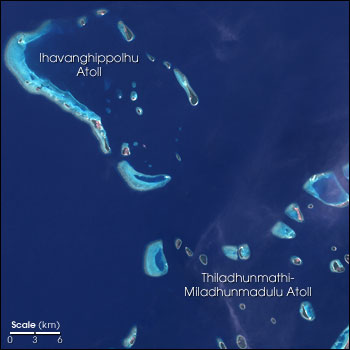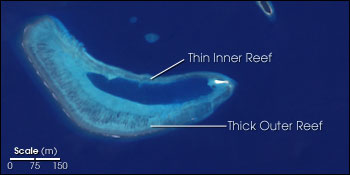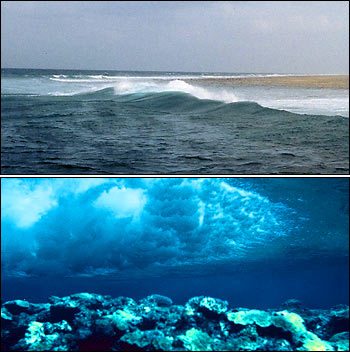| |
To prove that the monsoons shaped the coral reefs, Hatcher and Naseer
would have to demonstrate that a relationship exists between the two
across the entire atoll cluster. Moreover, they would have to compare
the monsoon weather data such as wind speed, rainfall, and wave height
over several decades to detailed maps of the reefs. But when they went
looking for this information, they ran into the same old problem. Though
the climate data were there, detailed maps of the atolls were
non-existent. The only maps of the Maldives were English admiralty
charts from 1896 and modern maps drawn to a scale of one to three
hundred thousand. "They were all maps that were designed for
navigating the waters amongst the islands. We needed maps with enough
detail to see the submerged reef habitats at the scale of about one to
ten thousand," says Hatcher.
|
|
|
| |

The
researchers eventually found a solution to this largely academic
dilemma in a seemingly unlikely place–the Landsat 7 satellite.
Launched in 1999, Landsat 7 orbits approximately from pole to pole
around the Earth. An instrument on board, known as the Enhanced Thematic
Mapper Plus (ETM+), measures the infrared and reflected solar radiation
from the surface of our revolving planet. These readings are beamed as
digital data to receiving stations on the ground where scientists can
convert them into meaningful images of the Earth. With a resolution on
the order of 30 by 30 meters per pixel, the images are not well suited
for viewing details on our planet’s surface any smaller than an
office building. They are, however, extremely useful for mapping and
monitoring large features such as coral atolls.
Traditionally, Landsat 7 has been used to track change in land cover
such as deforestation. At the request of a group of scientists at the
University of South Florida and NASA’s Goddard Space Flight Center,
NASA agreed to modify the Landsat 7 image acquisition strategy to begin
monitoring shallow ocean regions. For the past two years the group has
been using these images as part of an effort to map and monitor the
health of coral reefs around the globe. They passed their images of the
Maldives along to Hatcher, who saw them as the perfect means with which
to test their hypothesis. Not only were the images relatively
inexpensive, but they were detailed enough to make out the coral reef
habitat and extensive enough to cover the entire atoll archipelago.
Of course, the satellite images did not come classified and labeled.
The researchers had to take the raw data and demarcate the individual
reefs and any other features in the image that would be helpful in
uncovering the effects of the monsoons on the atoll reefs. More
specifically, they needed to know the dimensions and orientation of each
reef’s growth features, which include the reef crest, the reef
slope, the shallow and deep reef lagoons, the sand flats, and the
vegetated islands.
|
|
Satellite imagery provides the wide-area
images required to map the atolls of the Maldives. By comparing reef
structures throughout the archipelago, scientists can determine what effect
predominant weather patterns have on coral growth. (Image courtesy Abdulla Naseer, Dalhousie University) |
| |

As
most of their work is carried out on a university campus in Nova
Scotia, the researchers had to rely on their expertise regarding coral
reefs, their prior knowledge of the Maldives, and an array of remote
sensing techniques to map each atoll. In some instances, the process was
as easy as outlining an area that looks like a reef or a sand flat. In
other instances, complex computer programs involving fuzzy logic were
used to bring out the various categories. In the end, they found they
could obtain very detailed maps of the Maldives’ reefs from Landsat
7, and the whole endeavor took only a fraction of the time needed to map
the reefs by airplane or boat and cost a great deal less. "Landsat
7’s ability to consistently and rapidly map reefs has given us the
power to test hypotheses with a level of efficiency unheard before in
marine geological research," says Hatcher.
The researchers will employ a Geographic Information System (GIS) to
match their atoll maps point for point with the wind, rain, and wave
height data taken in the Maldives over the last 20 to 30 years. Though
only 20 percent of the reefs have been accounted for so far, the results
seem to confirm the researchers’ hypothesis. The sections of the
atolls facing in the direction of the monsoon winds–east and
west–are wider and slope more gradually into the sea. Those reefs
that were not exposed to the monsoons, either because they face another
direction or because they were shielded by other reef formations, had
more of wedge shape profile with narrow reef crests and steep slopes.
"Though we are in the early stages of the project, the asymmetries
are consistent with the geographic pattern of the monsoons," says
Naseer.
|
|
This high-resolution satellite image,
a detaill of the one above, is suggestive of how the monsoons shape the reefs. The wide,
outer edges of the reefs face the monsoon winds, while the thin, inner edge
is protected from them. (Image courtesy Abdulla Naseer, Dalhousie University) |
| |
 Since
the atolls do not show obvious signs of erosion, Hatcher says
they likely maintained the same shape throughout the latest rise in sea
level (125 m) that began with the end of the last ice age 12,000 years
ago. Several lines of evidence suggest that the monsoons in that region
of the world have blown with the same strength and direction for many
tens of thousands of years. As these atolls grew above the volcanic
mountain range that forms the backbone of the Maldivian archipelago, the
monsoons acted to continually mold the size and shape of the reefs.
"So in a way both [Darwin’s and Dana’s theories] were
correct for the Maldives," says Hatcher. Though the atolls’
overall shape remains roughly the same for hundreds of feet under the
ocean's surface, they have been continually shaped by the region’s
dominant weather patterns.
 Battling a Rising Tide Battling a Rising Tide
 Blowing in the Wind Blowing in the Wind
|
|
In the Maldives, monsoon winds drive waves, which stir
up the nutrients needed by the corals. Preliminary research indicates that reefs exposed to
the monsoons grow wider than those that are sheltered. (Photographs courtesy Bruce Hatcher, Dalhousie University) |

